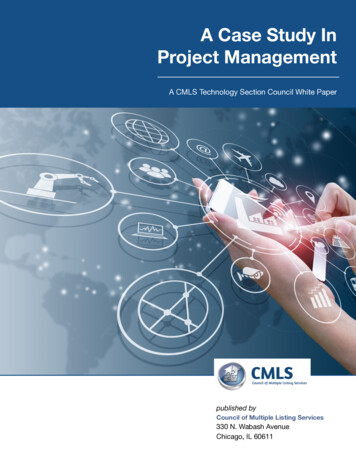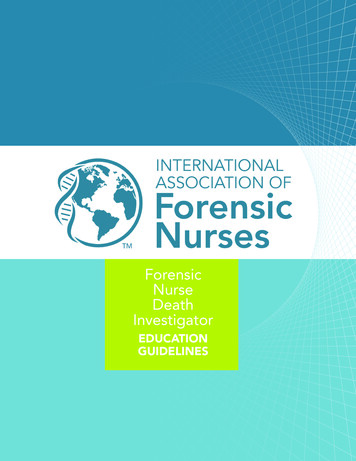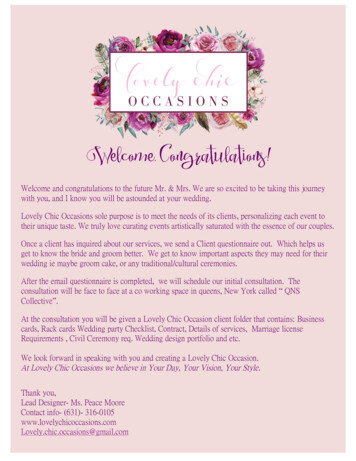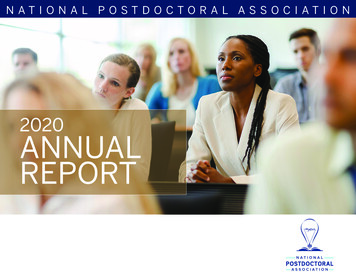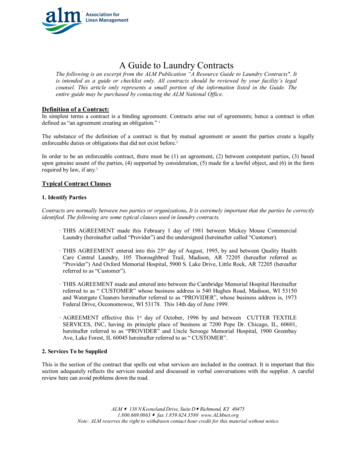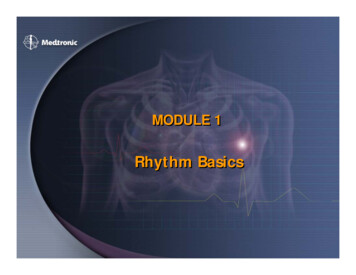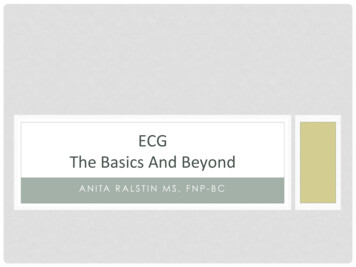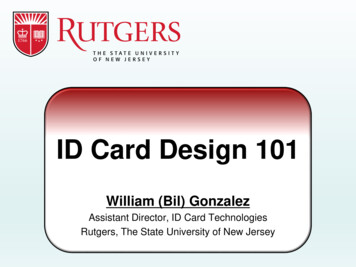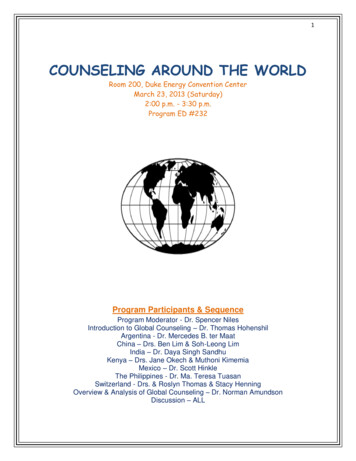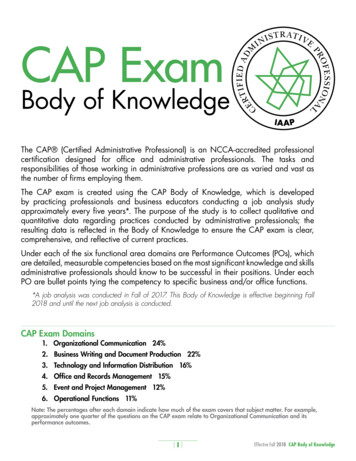
Transcription
CAP ExamBody of KnowledgeThe CAP (Certified Administrative Professional) is an NCCA-accredited professionalcertification designed for office and administrative professionals. The tasks andresponsibilities of those working in administrative professions are as varied and vast asthe number of firms employing them.The CAP exam is created using the CAP Body of Knowledge, which is developedby practicing professionals and business educators conducting a job analysis studyapproximately every five years*. The purpose of the study is to collect qualitative andquantitative data regarding practices conducted by administrative professionals; theresulting data is reflected in the Body of Knowledge to ensure the CAP exam is clear,comprehensive, and reflective of current practices.Under each of the six functional area domains are Performance Outcomes (POs), whichare detailed, measurable competencies based on the most significant knowledge and skillsadministrative professionals should know to be successful in their positions. Under eachPO are bullet points tying the competency to specific business and/or office functions.*A job analysis was conducted in Fall of 2017. This Body of Knowledge is effective beginning Fall2018 and until the next job analysis is conducted.CAP Exam Domains1. Organizational Communication 24%2. Business Writing and Document Production 22%3. Technology and Information Distribution 16%4. Office and Records Management 15%5. Event and Project Management 12%6. Operational Functions 11%Note: The percentages after each domain indicate how much of the exam covers that subject matter. For example,approximately one quarter of the questions on the CAP exam relate to Organizational Communication and itsperformance outcomes. 1 Effective Fall 2018 CAP Body of Knowledge
CAP Core Resources*Each domain lists subject-specific recommended readings; however, these four textbooks contain a wide variety ofcontent covered on the CAP examination. These resources serve as good general reference material when studying.Bovee, C. L., and J. V. Thill. Business Communication Today, 13th Edition. Pearson Prentice-Hall, 2015.Colquitt, J. A., LePine, J. A., and M. Wesson. Organizational Behavior: Improving Performance andCommitment in the Workplace, 5th Edition. McGraw-Hill, 2017.Rankin, D., and K. Shumack. The Administrative Professional: Technology and Procedures, 15th Edition.Cengage Learning, 2017.Vermaat, M. E., S. L. Sebok, S. M. Freund, J. T. Campbell, and M. Frydenberg. Discovering Computers 2018Digital Technology, Data, and Devices. Cengage Learning, 2018.*Questions written for the CAP examination are referenced to one the CAP Core Resources and/or recommended readingsor similar texts on the topic from the same date range.DOMAIN ONE: ORGANIZATIONAL COMMUNICATIONRecommended Readings for Organizational CommunicationBovee, C. L., and J. V. Thill. Business Communication Today, 13th Edition. Pearson Prentice-Hall, 2015.Colquitt, J. A., LePine, J. A., and M. Wesson. Organizational Behavior: Improving Performance and Commitment in theWorkplace, 5th Edition. McGraw-Hill, 2017.Rankin, D., and K. Shumack. The Administrative Professional: Technology and Procedures, 15th Edition. CengageLearning, 2017.Shockley-Zalabak, Pamela. Fundamentals of Organizational Communication, 9th Edition. Pearson, 2014.Related College CoursesBusiness CommunicationIntroduction to Organizational LeadershipPrinciples of Business ManagementOrganizational CommunicationPO 1: Describe the concepts and applications of communication, management, and leadership models/theorieswithin organizations. Identify the various types of communication (written, verbal, nonverbal, interpersonal, group, public) and which is themost effective for different business situations Describe management/leadership theories and how they relate to effective organizational communicationPO 2: Describe the process of effective interaction with internal and external stakeholders of an organization. Demonstrate a basic knowledge and proficiency in managing and resolving conflict within an organizationPO 3: Recognize the importance and utilization of professional networking. Describe how networking (both in-person and virtual) has changed the way people find jobs and companies recruitnew employees 2 Effective Fall 2018 CAP Body of Knowledge
PO 4: Demonstrate an understanding of team dynamics within organizations. Identify the different types of teams and describe their purpose Describe the specific kinds of dynamics within teams and how they can be managed Demonstrate knowledge in effective decision making, communication, and team buildingPO 5: Describe the positive and negative types of interpersonal interactions existing within an organization. Explain how human motivation affects organizational dynamics Demonstrate basic knowledge of the differences between managing and leading Explain the dynamics of mentorship and coaching, including the effect on performancePO 6: Demonstrate knowledge in the techniques of creating and giving presentations. Describe how to apply methods of coping with communication anxiety Identify the different types of presentations and appropriate usage of each Demonstrate knowledge of how to prepare for and deliver a presentationPO 7: Demonstrate the ability to conduct business with diverse cultures. Describe international business practices with regard to cultural norms and rituals Demonstrate knowledge of the importance of multicultural communication in today’s workplacePO 8: Demonstrate a basic knowledge in organizational structure, systems, and strategies including their role inproductivity and effective management. Describe the parts of a strategic plan and how it affects organization performance Define various organization management systems that examine productivity (such as Six Sigma and TQM)PO 9: Describe how confidentiality, legality, and ethics are important for the functioning of an organization. Understand basic employer and employees’ rights with regard to legalityDOMAIN TWO: BUSINESS WRITING AND DOCUMENT PRODUCTIONRecommended Readings for Business Writing and Document ProductionCovey, Stephen F. Style Guide for Business and Technical Communication, 5th Edition. Pearson FT Press PTG, 2012.Guffey, M. E., and D. Loewy. Essentials of Business Communication, 10th Edition. South-Western Publishing Co., 2015.Rankin, D., and K. Shumack. The Administrative Professional: Technology and Procedures, 15th Edition. CengageLearning, 2017.Related College CoursesBusiness EnglishBusiness CommunicationIntroduction to Word ProcessingDesktop Publishing for the OfficePO 1: Demonstrate knowledge of terminology associated with business writing and document production. Identify the different functions of correspondence, documents, and reports within an organization Describe which method is best for creating and distributing reports and documents within an organization Identify best practices for developing business communications such as research, audience analysis, and composition 3 Effective Fall 2018 CAP Body of Knowledge
PO 2: Exhibit proficiency in proofreading and editing documents. Demonstrate knowledge of document readability for business communication Identify and describe the most important steps when editing and proofreading Apply the basics of copy editing for various types of documentsPO 3: Demonstrate proficiency in the use of grammar, spelling, and sentence construction. Demonstrate ability to apply basic rules of English grammar, especially spelling, punctuation, capitalization, andsentence constructionPO 4: Describe the steps required to create and edit different types of business documents. Demonstrate an ability to determine and develop materials for the appropriate audience for different types ofbusiness documents Exhibit knowledge of which software applications are appropriate to produce common business documents (e.g., MSWord, Google Docs, Adobe Acrobat) Demonstrate proficiency in spreadsheet creation, including simple formulas and data manipulation Understand the application and use of presentation software (e.g., MS PowerPoint, Prezi, etc.)PO 5: Describe the features and tools used in desktop publishing for newsletter, flyers, etc. Exhibit knowledge of desktop design software including features and functions Identify important aspects of layout and design Demonstrate a familiarity with online tools for web publishing Recognize basic graphic design tools for office and web publishingPO 6: Identify the necessary elements needed to create and present effective charts and graphs. Demonstrate knowledge of software applications used to create, format, and insert charts, tables, and graphs intobusiness documents and presentationsPO 7: Identify the important elements necessary for finishing a document (e.g., binding, collation, stapling,coloring, graphics, etc.) Describe the key differences and requirements for electronic versus hard-copy output of documentsPO 8: Demonstrate proficiency in the creation of minutes for meetings. Identify how to prepare minutes for a meeting, capturing the essence of agenda items and actions takenDOMAIN THREE: TECHNOLOGY AND INFORMATION DISTRIBUTIONRecommended Readings for Technology and Information DistributionRankin, D., and K. Shumack. The Administrative Professional: Technology and Procedures, 15th Edition. CengageLearning, 2017.Vermaat, M. E., S. L. Sebok, S. M. Freund, J. T. Campbell, and M. Frydenberg. Discovering Computers 2018 DigitalTechnology, Data, and Devices. Cengage Learning, 2018.Related College CoursesBusiness Computer ApplicationsBusiness Office and Administrative ProceduresIntroduction to Computing 4 Effective Fall 2018 CAP Body of Knowledge
PO 1: Describe the process of information distribution within an office environment. Demonstrate knowledge in how to organize distribution lists for various types of communicationsPO 2: Identify the important differences between traditional and electronic distribution of information. Demonstrate knowledge and proficiency of different email interface types Know which software and technology is available for distributing informationPO 3: Identify copyright laws, regulations regarding intellectual property, and ways to maintain confidentialitywhen distributing information. Identify proper attribution of quotations from published documentsPO 4: Describe the process and techniques of gathering, compiling, and analyzing data. Exhibit knowledge of which software applications are appropriate for compiling, storing, and analyzing data Demonstrate a clear understanding of which data are appropriate to collect and why Demonstrate a proficiency in creating a well-organized report with regard to organization and data visualizationPO 5: Demonstrate knowledge in the use of the Internet, including social media, as a way of distributinginformation. Identify and describe the important characteristics of sending email (e.g., etiquette, attachments, formatting, etc.) Demonstrate knowledge and proficiency in social media usage and etiquette Exhibit knowledge of which social media applications are appropriate for a specific task and how to use themPO 6: Demonstrate basic knowledge in the installation, maintenance, and troubleshooting of both equipment andsoftware. Identify various computer hardware used in an office Demonstrate knowledge of basic office software and functions Identify available online resources for equipment and software training and usagePO 7: Demonstrate basic knowledge in the use of different types of computer systems. Identify potential issues with compatibility of different operating systems, such as Microsoft and ApplePO 8: Describe common ways of storing and transferring data and the types of media appropriate for each. Demonstrate knowledge and proficiency in identifying file types and the appropriate ways of converting documents Exhibit knowledge of software programs used for document conversion Identify and describe common procedures of backing up electronic information and databases, including cloudstoragePO 9: Explain appropriate security procedures for maintaining, backing up, and storing information. Demonstrate knowledge of legal issues regarding the storing of electronic informationDOMAIN FOUR: OFFICE AND RECORDS MANAGEMENTRecommended Readings for Office and Records ManagementRankin, D., and K. Shumack. The Administrative Professional: Technology and Procedures, 15th Edition. CengageLearning, 2017.Read, J. and M. L. Ginn. Records Management, 10th Edition. Cengage Learning, 2016. 5 Effective Fall 2018 CAP Body of Knowledge
Related College CoursesRecords ManagementBusiness Office and Administrative ProceduresPO 1: Demonstrate knowledge of basic terminology associated with records management using ARMA Guidelines. Prove knowledge of terms such as metadata, records retention, and data archiving Demonstrate familiarity with terms used by ARMA and general records managementPO 2: Identify the key advantages and disadvantages of electronic and manual (paper) file management basedon ARMA Guidelines. Demonstrate usage of both paper and electronic filing systems as appropriate based on access requirements andorganizational needsPO 3: Demonstrate knowledge of both electronic and manual (paper) filing rules and standards based on ARMAGuidelines. Describe types of electronic files, naming conventions, options for accessing, and methods of altering information Exhibit knowledge of available software, systems, and services for electronic filing Describe the different methods for creating, storing, and retaining filesPO 4: Identify the appropriate security for both electronic and manual files. Identify the key laws regarding record storage and confidentiality Describe both the strengths and weaknesses of types of record and file securityPO 5: Demonstrate knowledge of file retrieval, maintenance, and retention. Describe how to develop a record retention schedule for both electronic
The CAP exam is created using the CAP Body of Knowledge, which is developed by practicing professionals and business educators conducting a job analysis study approximately every five years*. The purpose of the study is to collect qualitative and quantitative data regarding practices conducted by administrative professionals; the resulting data is reflected in the Body of Knowledge to ensure .File Size: 176KBPage Count: 8


